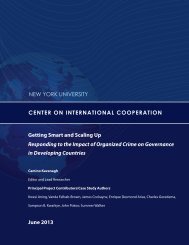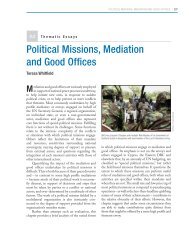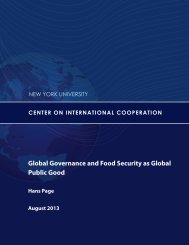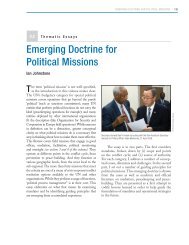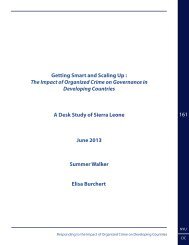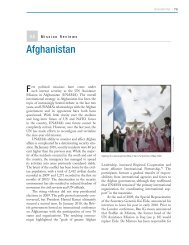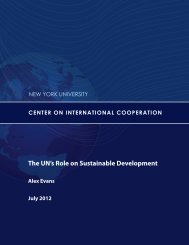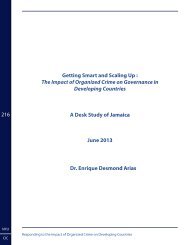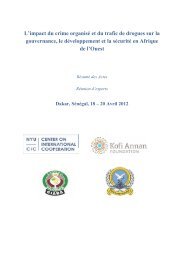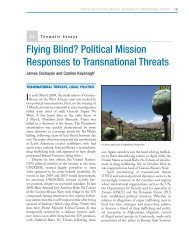here - Center on International Cooperation - New York University
here - Center on International Cooperation - New York University
here - Center on International Cooperation - New York University
Create successful ePaper yourself
Turn your PDF publications into a flip-book with our unique Google optimized e-Paper software.
90 | Missi<strong>on</strong> ReviewsUN Missi<strong>on</strong> in Nepal (UNMIN)Authorizati<strong>on</strong> 23 January 2007and Start Date (UNSC Res. 1740)SRSGKarin Landgren (Sweden)Budget $16.7 milli<strong>on</strong> (1 January 2010-31 December 2010)Strength as of Internati<strong>on</strong>al Civilian: 43early 2010 Local Civilian: 118Military Experts <strong>on</strong> Missi<strong>on</strong>: 68UN Volunteers: 16For detailed missi<strong>on</strong> informati<strong>on</strong> see p. 202arms and armies, technical assistance to the electoralprocess, and support to the m<strong>on</strong>itoring ofthe broader aspects of the ceasefire. Moreover, fora missi<strong>on</strong> with military resp<strong>on</strong>sibilities, its armsm<strong>on</strong>itoring comp<strong>on</strong>ent was unusually light, c<strong>on</strong>sistingof unarmed arms m<strong>on</strong>itors (serving andretired officers) in civilian attire deployed withthe cooperati<strong>on</strong> of the parties. Given the shorttime frame with which it was c<strong>on</strong>ceived, UNMINwas not established as an integrated missi<strong>on</strong>,although it assumed an “integrated approach” toits resp<strong>on</strong>sibilities.That UNMIN took shape at all was ac<strong>on</strong>sequence of careful political work by the UNduring the three years preceding the signing of theCPA, as well as the successful deployment of anOffice of the UN High Commissi<strong>on</strong>er for HumanRights (OHCHR) in Nepal in mid-2005. The UN’spolitical involvement in Nepal dated back to September2002, when Secretary-General Kofi Annanhad offered to “c<strong>on</strong>sider the use of his good officesto help achieve a peaceful soluti<strong>on</strong>” to Nepal’s c<strong>on</strong>flict.1 On the basis of this offer, Tamrat Samuel, anofficial within the Department of Political Affairs,began visiting the country in mid-2003 and engagingwith all political actors, including the Maoists.Reservati<strong>on</strong>s that India – the regi<strong>on</strong>al powerand a neighbor with both significant interests inand major influence over Nepal – and some Nepalisheld about an overt “political” role for the UNc<strong>on</strong>tributed to the narrow definiti<strong>on</strong> of UNMIN’smandate. This would emerge as a core weakness ofthe missi<strong>on</strong> and the source of ambiguity and c<strong>on</strong>fusi<strong>on</strong>about its role.UNMIN’s arms m<strong>on</strong>itoring and electoral assistancec<strong>on</strong>tributed positively to Nepal’s ability tohold an electi<strong>on</strong> in April 2008 that was recognizedas “remarkable and relatively peaceful.” 2 However,a poor understanding of the mandate in Nepal– never effectively countered by UNMIN’s c<strong>on</strong>siderableefforts at communicati<strong>on</strong> and outreach– created a situati<strong>on</strong> in which high expectati<strong>on</strong>s ofthe UN’s c<strong>on</strong>tributi<strong>on</strong> were inevitably disappointed,even as some of those opposed to a more active UNrole pushed back against UNMIN’s initiatives. Themissi<strong>on</strong> numbered a little over 1,000 nati<strong>on</strong>al andinternati<strong>on</strong>al staff at its pre-electi<strong>on</strong> maximum andsubsequently downsized to less than 300. That itwas small in comparis<strong>on</strong> to most UN peace operati<strong>on</strong>scould not redress Nepali percepti<strong>on</strong>s thatits c<strong>on</strong>siderable size compared unfavorably to itsimpact up<strong>on</strong> the parties.UNMIN’s original mandate was designedwith the horiz<strong>on</strong> represented by the electi<strong>on</strong>s tothe c<strong>on</strong>stituent assembly in mind. Some politicalparties had supported the electoral process – andthe UN role within it – with the expectati<strong>on</strong> thatit would c<strong>on</strong>clude with the Maoists’ defeat. TheMaoists’ success at the polls c<strong>on</strong>sequently changedNepal’s political landscape dramatically. In thepost-electi<strong>on</strong> period a lack of cooperati<strong>on</strong> betweenthe political parties undermined further progressand proved a complicating factor for UNMIN.Indeed the missi<strong>on</strong>’s mandate, linked to the “temporary”but <strong>on</strong>going presence of two cant<strong>on</strong>ed andbarracked armies, became increasingly out of kilterwith the challenges Nepal now encountered.UNMIN quite properly retained the peace processas the center of its activities. However, that thepeace process assumed a central role in the l<strong>on</strong>gerterm calculati<strong>on</strong>s of either Nepal’s various politicalactors – locked in a struggle for power – or India, nol<strong>on</strong>ger appeared evident.UNMIN downsized promptly in June 2008;its electoral affairs and civil affairs offices – whichhad been specifically linked to creating the c<strong>on</strong>diti<strong>on</strong>sfor the electi<strong>on</strong> – and its five regi<strong>on</strong>al officeswere closed; arms m<strong>on</strong>itors were reduced from 186to 73 even as arms m<strong>on</strong>itoring remained a centralelement in the missi<strong>on</strong>’s work.The peace agreements reached in 2006 had notbeen able to negotiate the future of the armies fully,



